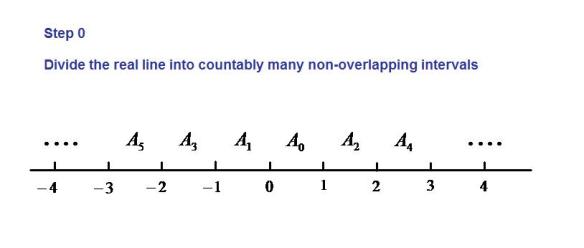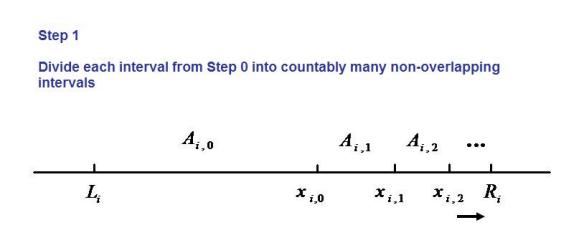A topological space is a Baire space if the intersection of any countable family of open and dense sets in
is dense in
(or equivalently, every nonempty open subset of
is of second category in
). One version of the Baire category theorem implies that every complete metric space is a Baire space. The real line
with the usual Euclidean metric
is a complete metric space, and hence is a Baire space. The space of irrational numbers
is also a complete metric space (not with the usual metric
but with another suitable metric that generates the Euclidean topology on
) and hence is also a Baire space. In this post, we show that there are subsets of the real line that are Baire space but not complete metric spaces. These sets are called Bernstein sets.
A Bernstein set, as discussed here, is a subset of the real line such that both
and
intersect with every uncountable closed subset of the real line. We present an algorithm on how to generate such a set. Bernstein sets are not Lebesgue measurable. Our goal here is to show that Bernstein sets are Baire spaces but not weakly
-favorable, and hence are spaces in which the Banach-Mazur game is undecidable.
Baire spaces are defined and discussed in this post. The Banach-Mazur game is discussed in this post. The algorithm of constructing Bernstein set is found in [2] (Theorem 5.3 in p. 23). Good references for basic terms are [1] and [3].
____________________________________________________________________________
In constructing Bernstein sets, we need the following lemmas.
Lemma 1
In the real line , any uncountable closed set has cardinality continuum.
Proof
In the real line, every uncountable subset of the real line has a limit point. In fact every uncountable subset of the real line contains at least one of its limit points (see The Lindelof property of the real line). Let be an uncountable closed set. The set
has to contain at least one of its limit point. As a result, at most countably many points of
are not limit points of
. Take away these countably many points of
that are not limit points of
and call the remainder
. The set
is still an uncountable closed set but with an additional property that every point of
is a limit point of
. Such a set is called a perfect set. In Perfect sets and Cantor sets, II, we demonstrate a procedure for constructing a Cantor set out of any nonempty perfect set. Thus
(and hence
) contains a Cantor set and has cardinality continuum.
Lemma 2
In the real line , there are continuum many uncountable closed subsets.
Proof
Let be the set of all open intervals with rational endpoints, which is a countable set. The set
is a base for the usual topology on
. Thus every nonempty open subset of the real line is the union of some subcollection of
. So there are at most continuum many open sets in
. Thus there are at most continuum many closed sets in
. On the other hand, there are at least continuum many uncountable closed sets (e.g.
for
). Thus we can say that there are exactly continuum many uncountable closed subsets of the real line.
Constructing Bernstein Sets
Let denote the cardinality of the real line
. By Lemma 2, there are only
many uncountable closed subsets of the real line. So we can well order all uncountable closed subsets of
in a collection indexed by the ordinals less than
, say
. By Lemma 1, each
has cardinality
. Well order the real line
. Let
be this well ordering.
Based on the well ordering , let
and
be the first two elements of
. Let
and
be the first two elements of
(based on
) that are different from
and
. Suppose that
and that for each
, points
and
have been selected. Then
is nonempty since
has cardinality
and only less than
many points have been selected. Then let
and
be the first two points of
(according to
). Thus
and
can be chosen for each
.
Let . Then
is a Bernstein set. Note that
meets every uncountable closed set
with the point
and the complement of
meets every uncountable closed set
with the point
.
The algorithm described here produces a unique Bernstein set that depends on the ordering of the uncountable closed sets and the well ordering
of
.
____________________________________________________________________________
Key Lemmas
Baire spaces are defined and discussed in this previous post. Baire spaces can also be characterized using the Banach-Mazur game. The following lemmas establish that any Bernstein is a Baire space that is not weakly -favorable. Lemma 3 is applicable to all topological spaces. Lemmas 4, 5, 6, and 7 are specific to the real line.
Lemma 3
Let be a topological space. Let
be a set of first category in
. Then
contains a dense
subset.
Proof
Let be a set of first category in
. Then
where each
is nowhere dense in
. The set
is a dense
set in the space
and it is contained in the complement of
. We have:
We now set up some notaions in preparation of proving Lemma 4 and Lemma 7. For any set , let
be the interior of the set
. Denote each positive integer
by
. In particular,
. Let
denote the collection of all functions
. Identify each
by the sequence
. This identification makes notations in the proofs of Lemma 4 and Lemma 7 easier to follow. For example, for
,
denotes a closed interval
. When we choose two disjoint subintervals of this interval, they are denoted by
and
. For
,
refers to
,
refers to the sequence
, and
refers to the sequence
and so on.
The Greek letter denotes the first infinite ordinal. We equate it as the set of all nonnegative integers
. Let
denote the set of all functions from
to
.
Lemma 4
Let be a dense
set. Let
be a nonempty open subset of
. Then
contains a Cantor set (hence an uncountable closed subset of the real line).
Proof
Let where each
is an open and dense subset of
. We describe how a Cantor set can be obtained from the open sets
. Take a closed interval
. Let
. Then pick two disjoint closed intervals
and
such that they are subsets of the interior of
and such that the lengths of both intervals are less than
. Let
.
At the step, suppose that all closed intervals
(for all
) are chosen. For each such interval, we pick two disjoint closed intervals
and
such that each one is subset of
and each one is subset of the interior of the previous closed interval
and such that the lenght of each one is less than
. Let
be the union of
over all
.
Then is a Cantor set that is contained in
.
Lemma 5
Let . If
is not of second category in
, then
contains an uncountable closed subset of
.
Proof
Suppose is of first category in
. By Lemma 3, the complement of
contains a dense
subset. By Lemma 4, the complement contains a Cantor set (hence an uncountable closed set).
Lemma 6
Let . If
is not a Baire space, then
contains an uncountable closed subset of
.
Proof
Suppose is not a Baire space. Then there exists some open set
such that
is of first category in
. Let
be an open subset of
such that
. We have
where each
is nowhere dense in
. It follows that each
is nowhere dense in
too.
By Lemma 3, contains
, a dense
subset of
. By Lemma 4, there is a Cantor set
contained in
. This uncountable closed set
is contained in
.
Lemma 7
Let . Suppose that
is a weakly
-favorable space. If
is dense in the open interval
, then there is an uncountable closed subset
of
such that
.
Proof
Suppose is a weakly
-favorable space. Let
be a winning strategy for player
in the Banach-Mazur game
. Let
be an open interval in which
is dense. We show that a Cantor set can be found inside
by using the winning strategy
.
Let . Let
. Let
and
. We take
as the first move by the player
. Then the response made by
is
. Let
.
Choose two disjoint closed intervals and
that are subsets of the interior of
such that the lengths of these two intervals are less than
and such that
and
satisfy further properties, which are that
and
are open in
. Let
and
be two possible moves by player
at the next stage. Then the two possible responses by
are
and
. Let
.
At the step, suppose that for each
, disjoint closed interval
have been chosen. Then for each
, we choose two disjoint closed intervals
and
, both subsets of the interior of
, such that the lengths are less than
, and:
and
,
and
are open in
,
and
We take and
as two possible new moves by player
from the path
. Then let the following be the responses by player
:
The remaining task in the induction step is to set
.
Let , which is a Cantor set, hence an uncountable subset of the real line. We claim that
.
Let . There there is some
such that
. The closed intervals
are associated with a play of the Banach-Mazur game on
. Let the following sequence denote this play:
Since the strategy is a winning strategy for player
, the intersection of the open sets in
must be nonempty. Thus
.
Since the sets , and since the lengths of
go to zero, the intersection must have only one point, i.e.,
for some
. It also follows that
. Thus
. We just completes the proof that
contains an uncountable closed subset of the real line.
____________________________________________________________________________
Conclusions about Bernstein Sets
Lemma 6 above establishes that any Bernstein set is a Baire space (if it isn’t, the complement would contain an uncountable closed set). Lemma 7 establishes that any Bernstein set is a topological space in which the player has no winning strategy in the Banach-Mazur game (if player
always wins in a Bernstein set, it would contain an uncountable closed set). Thus any Bernstein set cannot be a weakly
favorable space. According to this previous post about the Banach-Mazur game, Baire spaces are characterized as the spaces in which the player
has no winning strategy in the Banach-Mazur game. Thus any Bernstein set in a topological space in which the Banach-Mazur game is undecidable (i.e. both players in the Banach-Mazur game have no winning strategy).
One interesting observation about Lemma 6 and Lemma 7. Lemma 6 (as well as Lemma 5) indicates that the complement of a “thin” set contains a Cantor set. On the other hand, Lemma 7 indicates that a “thick” set contains a Cantor set (if it is dense in some open interval).
Reference
- Engelking, R., General Topology, Revised and Completed edition, Heldermann Verlag, Berlin, 1989.
- Oxtoby, J. C., Measure and Category, Graduate Texts in Mathematics, Springer-Verlag, New York, 1971.
- Willard, S., General Topology, Addison-Wesley Publishing Company, 1970.




